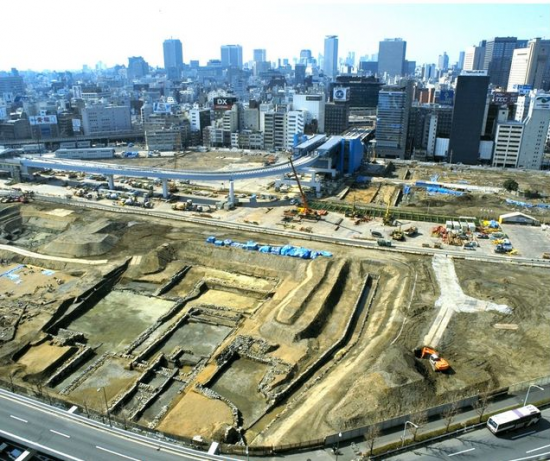Kazuaki Owaki
Source - http://ajw.asahi.com/article/behind_news/social_affairs/AJ201405240027

Numerous "train teapots" and teacups uncovered from the site of the old Shinbashi terminal, photographed in February 1992. (Asahi Shimbun file photo)
Shiodome, a bustling commercial center full of glass skyscrapers, epitomizes today's Tokyo, but the area was built, quite literally, on the ruins of history. Until 1991, when the project to revitalize the former rail yard began, few people knew that relics from the city's past lay beneath the ground.

The current view of the Shiodome ruins, taken in March 2014, now completely covered by skyscrapers (Naoko Kawamura)
An area approximately 266,000 square meters became dubbed the "Shiodome ruins," and this was where Susumu Saito, 56, of the Tokyo Metropolitan Archaeological Center discovered piles of brick, stone and concrete in April 1992. These structural materials were the ruins of the old Shinbashi terminal, thought to have been demolished after being damaged by the Great Kanto Earthquake in 1923.
"The top floors of the station had burnt down, but 20 centimeters below the ground was the basic structure still retaining its original form," says Saito.
The old Shinbashi terminal building, along with the old Yokohama Station, had been designed by American architect R.P. Bridgens (1819-1891) in the Meiji Era (1868-1912), but the original design of the building had long been a mystery because blueprints and other written records had been lost through the years.

Remnants of docks from the Edo Period (1603-1867) found under the Shiodome ruins, photographed in April 1995. In the foreground of the skyscrapers, monorail tracks and a station can be seen. (Provided by Tokyo Metropolitan Archaeological Center)
"Since the station continued to be used as a freight terminal after passenger use, the underground structure must have survived," presumes Saito.
After the opening of Tokyo Station just a few miles north in 1914, the old Shinbashi terminal ceased being used as a passenger rail station and became a freight terminal named Shiodome Station. Though the Great Kanto Earthquake destroyed the station building, the rail yard was rebuilt and continued to be used as a freight terminal.
As excavation revealed more of the old underground Shinbashi terminal, archaeologists found its platform had retained its original design. But the surprise did not end there.
Further digging exposed remnants of "daimyo's" (feudal lords') estates from the Edo Period (1603-1867), hidden below the foundations of the station building.
Originally a marsh filled with reeds, the Shiodome area became habitable after Tokugawa Ieyasu (1542-1616), the first shogun of the Tokugawa Shogunate, ordered it to be filled in to make land for daimyo estates. During the construction, dikes were built to stop the tide from flowing in and the area was hence named Shiodome (tide stopper).
Daimyo estates for the Aizu domain (part of present-day Fukushima Prefecture) were established in 1639, followed two years later by the estate for the Sendai domain (parts of present-day Miyagi and Iwate prefectures). The estate of the Tatsuno domain (part of present-day Hyogo Prefecture) was also established around the same time, all under the rule of the third shogun, Tokugawa Iemitsu (1604-1651).
Sizes of the estates varied, but for example, the estate for the Tatsuno domain comprised a mansion covering 4,500 square meters, townhouses covering 7,500 square meters and a garden covering 13,500 square meters.
Following the Meiji Restoration in 1868, the lands of the daimyo estates were confiscated by the new Meiji government, and the buildings were subsequently torn down to make way for the old Shinbashi terminal.
In October 1872, the first railroad in Japan was opened, connecting the 29 kilometers between Shinbashi and Yokohama.
In addition to finding the old station, the archaeological dig unearthed massive amounts of railroad artifacts, including steering wheels for trains, wire cutters and various tools, porcelain, wine bottles and glassware.
The items were discovered buried in a dump hole, 4.4 by 3.2 meters wide and 22 centimeters deep. What was junk then now provides a window into the Meiji Era.
Over 300 "train teapots" and 400 mugs were also found. Many of them were imprinted with names of stations, such as "Shizuoka" and "Shimonoseki," or of shops, such as "Haginoya."
A few, though, said "Victory of the Empire." Mariko Kawano, curator at the Railway History Exhibition Hall in the recreated Old Shinbashi Station said, "These teapots must have been made right after Japanese victories in the First Sino-Japanese War or the Russo-Japanese War."
"Train teapots" continued to be a popular item for railroad trips in Japan through the generations. What was once made of ceramic soon became made of glass, then plastic after the war, and finally into the familiar canned and bottled tea of today.
Over a decade has passed since the excavation project finished, and the majority of the Shiodome ruins has been filled in. But anyone curious about Meiji Era rail travel can relive the past at the Old Shinbashi Station, even if the trains are no longer there.